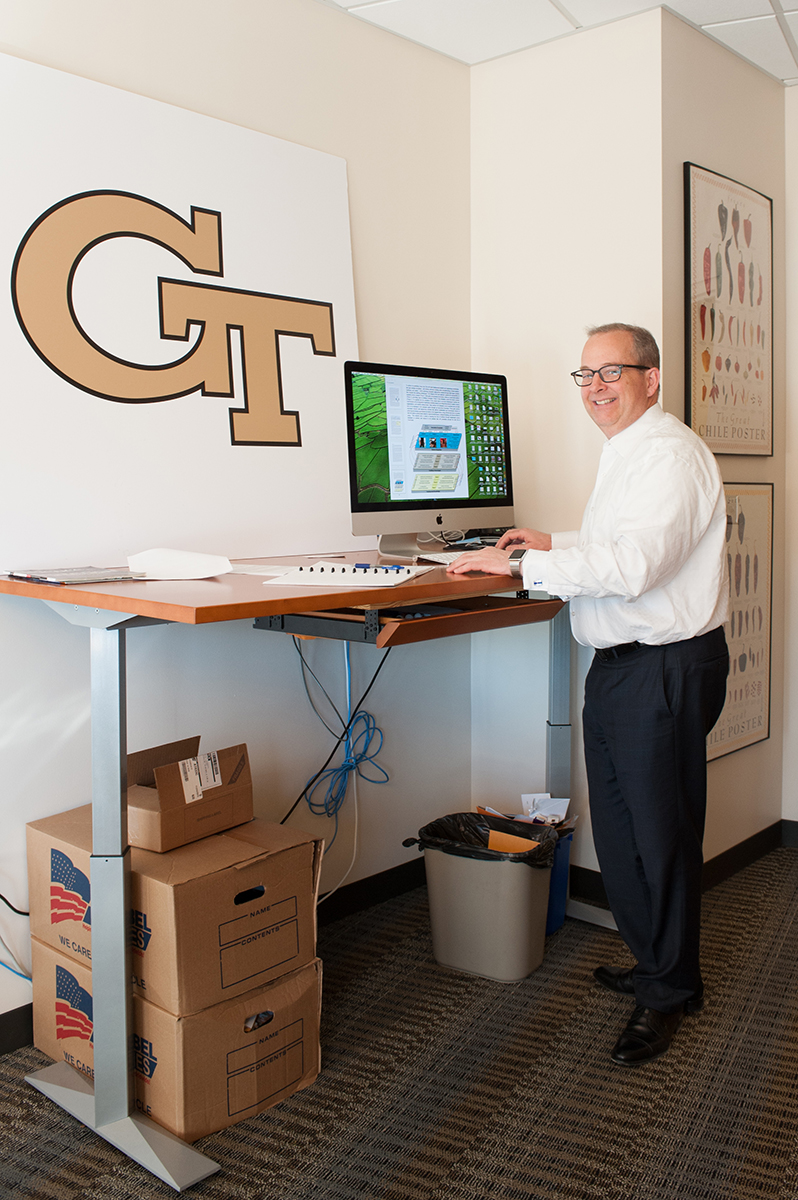Trending at Tech: More Employees Opting to ‘Stand and Deliver’

Every year, one of the most popular New Year’s resolutions is to get healthier. If you’ve set this goal for 2016, you may be able to work toward it without leaving your desk. How? By standing instead of sitting.
The standing desk is not new — notables like Thomas Jefferson, Charles Dickens, and Winston Churchill all stood up to work — but by the mid-20th century, the practice was viewed as eccentric. Now it’s trending again in workplaces all over the country, including Georgia Tech.
The main reason is growing evidence that sitting hour after hour, day after day, is bad for us. A study cited in Medicine & Science in Sports & Exercise found that people who sit for most of the day were 54 percent more likely to die of a heart attack. Prolonged sitting is also linked to obesity, Type 2 diabetes, back problems, and other conditions. Studies on top of studies, cited in article after article, have been spreading the word: The human body was not meant to sit for long stretches of time.
One person who read some of those articles was Stephen DeWeerth, professor and associate dean for Research and Innovation in the College of Engineering.
He thought a standing desk might help his back problems. So, with the blessings of his doctor, he ordered one in 2013. (At first, he even combined it with a modified treadmill to make a walking desk, but that proved incompatible with wearing a suit every day.)
“It has helped the back problems,” he said. “I definitely feel better that way.”
DeWeerth characterizes himself as a “complete convert” but not a “complete user,” estimating that he stands at his desk about two hours a day. He spends a lot of time in meetings, but that’s all the more reason to have a standing desk, he said. “Standing is a relief from the drudgery of sitting in meetings all day,” he said. “My back, my alertness, the kinds of things you might expect exercise would help with, this seems to help as well.”
Of course, DeWeerth is not the only Georgia Tech employee to unchain from the chair. Georgia Tech’s newest building, the Engineered Biosystems Building (EBB), has been furnished with adjustable desks throughout, a design decision based on the growing demand among faculty and staff for a standing option.
“The desk raises and lowers with the push of a button,” said Carla Zachery, the EBB’s director of Business Operations. “We have it as part of the original plan and not an additional cost down the road.”
In established offices with stationary desks, people are finding ways to create their own sit/stand options. Christian Duncan, senior IT professional for Institute Communications, said he has become an “unofficial expert” on standing desks, having configured more than a dozen setups for his coworkers since 2011.
“The decision was made in the department that if people wanted to stand, we would cover the cost as long as it could be done fairly cheaply,” he said. “We’ve found ways to get it done in the neighborhood of $150 to $200, sometimes less, depending on the situation.”
He typically uses three components to create a standing desk: a platform for the monitor, a lower platform for the keyboard (using stacks of paper to make finer height adjustments) and, last but not least, an anti-fatigue mat.
Duncan strives to ensure that users’ eyes hit about 25 to 33 percent down from the top of the monitor screen, and that their arms form a 90 degree angle when using the keyboard.
He also tells people: Prepare to hurt. “It normally takes about two to three weeks to break your body into this new setup,” he said.
Not every standing desk adopter adapts. Duncan estimates that about half the people in the department who started standing have kept at it.
But he agrees with experts that it’s not as much about standing continuously as it is moving regularly. He stands for some tasks and sits for others. “Doing anything for eight hours, whether it’s standing or sitting, is going to grate on you after a while.”